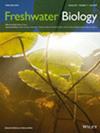Assessing Short- and Long-Term Anthropogenic Threats to a Reintroduced Fish in a Restored Urban Riverscape
IF 2.8
2区 生物学
Q2 ECOLOGY
引用次数: 0
Abstract
- Understanding which species can persist in human-modified environments is essential to biodiversity conservation in the Anthropocene. In urbanised environments, many stressors limit the persistence of imperilled native species via impacts on the abiotic and biotic environment. Habitat restoration followed by reintroduction of native species may be an effective strategy to maintain or even regenerate biodiversity in urbanised environments, but few studies have assessed these two conservation strategies concomitantly in urban freshwater ecosystems.
- We assessed short-term population dynamics and habitat associations of an endemic species of conservation concern, Guadalupe bass (Micropterus treculii, ‘GB’), that was reintroduced in a restored urbanised riverscape already occupied by a generalist congener, largemouth bass (M. salmoides, ‘LMB’). We performed four seasonal surveys of habitat association and one capture-mark-recapture survey of the two species at eight sites distributed along a 17 km reach of the San Antonio River within San Antonio, Texas—the seventh largest city in the United States.
- Detection of multiple size classes at all eight sites indicated that reintroduced GB have dispersed throughout this riverscape and are naturally recruiting. Juvenile GB were associated with restored riffles and transitioned to pools as adults—an ontogenetic habitat shift documented in rivers draining natural landscapes elsewhere in the GB native range. By contrast, juvenile and adult LMB were associated with pool habitats. Our results indicated that the construction of riffle habitats along this restored riverscape provide essential habitat for juvenile GB that was unavailable prior to restoration. Habitat overlap of adult bass indicated the potential for competition between the two species; however, GB body condition did not vary with LMB abundance across sites or seasons.
- Next, we assessed long-term stressors by comparing dispersal barriers, hydrologic alteration, pollution proxies and fish kill frequencies in the urbanised restored riverscape to minimally-impacted riverscapes throughout the native GB range. The urbanised restored riverscape was subject to more barriers, flashier hydrology and more pollution; however, these stressors did not translate to more frequently-documented fish kills in our study.
- We showed that restoration of instream habitat followed by reintroduction of native species enhanced urbanised biodiversity. Monitoring population responses to multiple urbanised stressors and mitigating those that threaten the long-term persistence of reintroduced species remains important.
评估在恢复的城市河景中重新引入鱼类的短期和长期人为威胁
了解哪些物种可以在人类改造的环境中生存,对于人类世的生物多样性保护至关重要。在城市化环境中,许多压力源通过对非生物和生物环境的影响限制了濒危本地物种的持久性。在城市化环境中,栖息地恢复后再引入本地物种可能是维持甚至再生生物多样性的有效策略,但很少有研究评估这两种保护策略在城市淡水生态系统中的同时进行。我们评估了具有保护意义的特有物种瓜达卢佩鲈鱼(Micropterus treculii, ' GB ‘)的短期种群动态和栖息地关联。瓜达卢佩鲈鱼被重新引入到一个已恢复的城市化河面中,该河面已经被一种通用的同族大口鲈鱼(M. salmoides, ’ LMB ')占据。我们在美国第七大城市德克萨斯州圣安东尼奥市的圣安东尼奥河沿岸17公里的8个地点对这两个物种进行了4次生境关联季节性调查和1次捕获-标记-再捕获调查。在所有8个地点检测到的多个大小类别表明,重新引入的GB已经分散在整个河流景观中,并且正在自然地招募。少年GB与恢复有关急流和转换到池adults-an个体发育的栖息地变化记录在河流排水自然景观在GB本机范围。相比之下,幼鱼和成鱼的LMB与池塘生境有关。研究结果表明,在恢复后的河景中,沿河景修建的小河沟生境为大蠊幼体提供了必要的栖息地。成鲈鱼的生境重叠表明两种之间存在竞争的潜力;然而,不同地点和季节的LMB丰度对GB体况没有影响。接下来,我们通过比较在整个原生GB范围内城市化恢复的河流景观和受影响最小的河流景观中的扩散障碍、水文变化、污染代理和鱼类死亡频率来评估长期压力源。城市化后恢复的河流景观面临着更多的屏障、更复杂的水文和更多的污染;然而,在我们的研究中,这些压力源并没有转化为更频繁记录的鱼类死亡。研究表明,河流栖息地的恢复和原生物种的重新引入增强了城市化的生物多样性。监测种群对多种城市化压力源的反应,并减轻那些威胁到重新引入物种长期持久性的压力,仍然很重要。
本文章由计算机程序翻译,如有差异,请以英文原文为准。
求助全文
约1分钟内获得全文
求助全文
来源期刊

Freshwater Biology
生物-海洋与淡水生物学
CiteScore
5.90
自引率
3.70%
发文量
162
审稿时长
2 months
期刊介绍:
Freshwater Biology publishes papers on all aspects of the ecology of inland waters, including rivers and lakes, ground waters, flood plains and other freshwater wetlands. We include studies of micro-organisms, algae, macrophytes, invertebrates, fish and other vertebrates, as well as those concerning whole systems and related physical and chemical aspects of the environment, provided that they have clear biological relevance.
Studies may focus at any level in the ecological hierarchy from physiological ecology and animal behaviour, through population dynamics and evolutionary genetics, to community interactions, biogeography and ecosystem functioning. They may also be at any scale: from microhabitat to landscape, and continental to global. Preference is given to research, whether meta-analytical, experimental, theoretical or descriptive, highlighting causal (ecological) mechanisms from which clearly stated hypotheses are derived. Manuscripts with an experimental or conceptual flavour are particularly welcome, as are those or which integrate laboratory and field work, and studies from less well researched areas of the world. Priority is given to submissions that are likely to interest a wide range of readers.
We encourage submission of papers well grounded in ecological theory that deal with issues related to the conservation and management of inland waters. Papers interpreting fundamental research in a way that makes clear its applied, strategic or socio-economic relevance are also welcome.
Review articles (FRESHWATER BIOLOGY REVIEWS) and discussion papers (OPINION) are also invited: these enable authors to publish high-quality material outside the constraints of standard research papers.
 求助内容:
求助内容: 应助结果提醒方式:
应助结果提醒方式:


